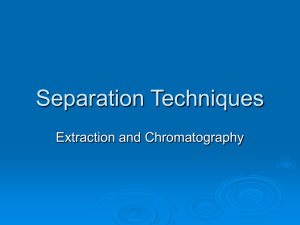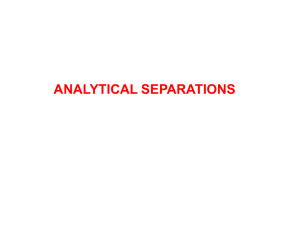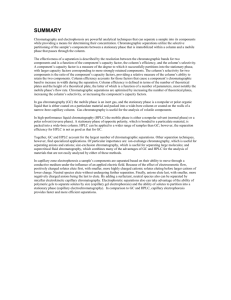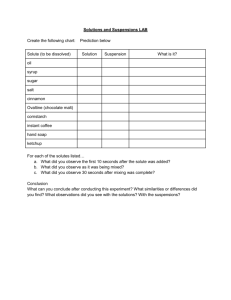An Introduction to Chromatographic Separations
advertisement
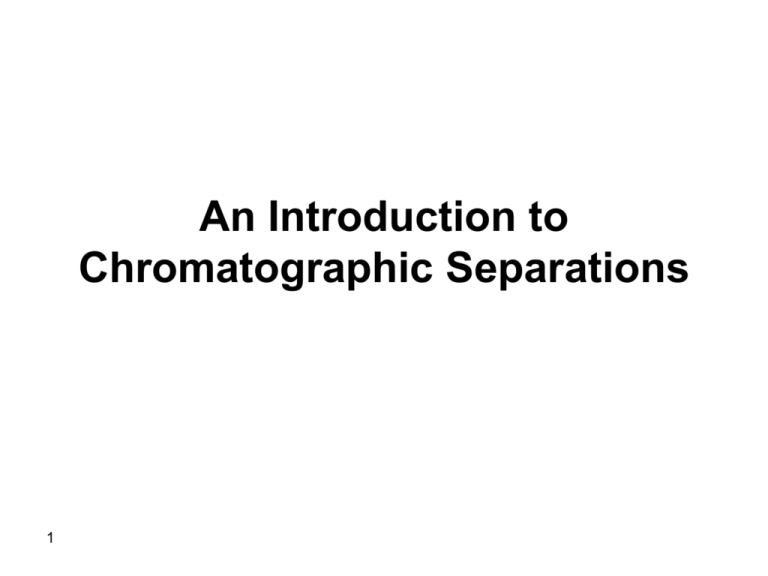
An Introduction to
Chromatographic Separations
1
An Introduction to
Chromatographic Separations
It was Mikhail Tswett, a Russian botanist,
in 1903 who first invented and named
liquid chromatography. Tswett used a
glass column filled with finely divided
chalk (calcium carbonate) to separate
plant pigments. He observed the
separation of colored zones or bands
along the column, hence name
chromatography, where Greak chroma
means color and graphein means write.
2
3
4
The development of chromatography was
slow for reasons to be discussed later
and scientists waited to early fifties for
the first chromatographic instrument to
appear in the market (a gas
chromatograph). However, liquid
chromatographic equipment with
acceptable performance was only
introduced about two decades after gas
chromatography.
5
6
General Description of
Chromatography
In a chromatographic separation of any type, different
components of a sample are transported in a mobile
phase (a gas, a liquid, or a supercritical fluid). The
mobile phase (also called eluent) penetrates or
passes through a solid or immiscible stationary
phase. Solutes (eluates) in the sample usually have
differential partitioning or interactions with the
mobile and stationary phases. Since the stationary
phase is the fixed one then those solutes which have
stronger interactions with the stationary phase will
tend to move slower (have higher retention times)
than others which have lower or no interactions with
the stationary phase will tend to move faster.
7
Therefore, chromatographic separations are a
consequence of differential migration of
solutes. It should be remembered that
maximum interactions between a solute and
a stationary phase take place when both
have similar characteristics, for example in
terms of polarity. However, when their
properties are so different, a solute will not
tend to stay and interact with the stationary
phase and will thus prefer to stay in the
mobile phase and move faster; a polar
solvent and a non polar stationary phase is a
good example.
8
According to the nature of the mobile phase,
chromatographic techniques can be
classified into three classes:
1. Liquid chromatography (LC)
2. Gas chromatography (GC)
3. Supercritical fluid chromatography (SFC)
Other classifications are also available where
the term column chromatography where
chromatographic separations take place
inside a column, and planar
chromatography, where the stationary
phase is supported on a planar flat plate,
are also used.
9
Elution Chromatography
The term elution refers to the actual process of
separation. A small volume of the sample is
first introduced at the top of the
chromatographic column. Elution involves
passing a mobile phase inside the column
whereby solutes are carried down the stream
but on a differential scale due to interactions
with the stationary phase. As the mobile
phase continues to flow, solutes continue to
move downward the column. Distances
between solute bands become greater with
time and as solutes start to leave the column
they are sequentially detected.
10
11
The time a solute spends in a column
(retention time) depends on the fraction of
time that solute spends in the mobile phase.
As solutes move inside the column, their
concentration zone continues to spread and
the extent of spreading (band broadening)
depends on the time a solute spends in the
columns. Factors affecting band broadening
are very important and will be discussed
later. The dark colors at the center of the
solute zones in the above figure represent
higher concentrations than are
concentrations at the sides. This can be
represented schematically as:
12
13
Chromatograms
The plot of detector signal (absorbance,
fluorescence, refractive index, etc..) versus
retention time of solutes in a
chromatographic column is referred to as a
chromatogram. The areas under the peaks in
a chromatogram are usually related to solute
concentration and are thus very helpful for
quantitative analysis. The retention time of a
solute is a characteristic property of the
solute which reflects its degree of interaction
with both stationary and mobile phases.
Retention times serve qualitative analysis
parameters to identify solutes by comparison
with standards.
14
Migration Rates of Solutes
The concepts which will be developed in
this section will be based on separation
of solutes using a liquid mobile phase
and an immiscible liquid stationary
phase. This case is particularly
important as it is a description of the
most popular processes.
15
Distribution Constants
Solutes traveling inside a column will interact with both
the stationary and mobile phases. If, as is our case,
the two phases are immiscible, partitioning of
solutes takes place and a distribution constant, K,
can be written:
K = CS/CM
(1)
Where; CS and CM are the concentrations of solute in
the stationary and mobile phases, respectively. If a
chromatographic separation obeys equation 1, the
separation is called linear chromatography. In such
separations peaks are Gaussian and independent of
the amount of injected sample
16
The time required for an analyte to travel
through the column after injection till
the analyte peak reaches the detector is
termed the retention time. If the sample
contains an unretained species, such
species travels with the mobile phase
where the time spent by that species to
exit the column is called the dead or
void time, tM. Solutes will move towards
the detector in different speeds,
according to each solute’s nature.
17
Chromatography
Retention Times
tM = retention time of mobile phase (dead time)
tR = retention time of analyte (solute)
tR’ = time spent in stationary phase (adjusted retention time)
L = length of the column
18
Chromatography: Velocities
Linear rate of solute migration!
Velocity = distance/time length of column/ retention times
19
Velocity of solute:
L
v
tR
Velocity of mobile phase:
L
tM
average linear velocity of a solute, v, can be
written as:
v = L/tR
(2)
Where, L is the column length and tR is the
retention time of the solute. The mobile
phase linear velocity, u, can be written as:
u = L/tM
(3)
The linear velocity of solutes is a fraction of
the linear velocity of the mobile phase. This
can be written as:
v = u * moles of solute in mp/total moles of
solute
20
Chromatography
Velocity/Retention time and Kc
v fraction of time in mobile phase
moles of solute in mobile phase
v
total moles of solute
21
cMVM
v
cMVM cSVS
This can be further expanded by substitution
for the moles of solute in mp, CMVM, and the
total number of moles of solute, CMVM + CSVS.
v = u * CMVM / (CMVM + CSVS)
Dividing both nominator and denominator by
CMVM we get
v = u * 1/ (1 + CSVS/ CMVM)
(4)
Now, let us define a new distribution constant,
called the capacity or retention factor, k’, as:
k’ = CSVS/ CMVM = K VS/VM
(5)
22
Substitution of 1,2 and 5 in equation 4 we
get:
L/tR = L/tM * {1/(1 + k’)}
Rearrangement gives:
tR = tM (1+k’)
(6)
This equation can also be written as:
k’ = (tR – tM)/tM
23
The Selectivity Factor
For two solutes to be separated, they should have
different migration rates. This is referred to as
having different selectivity factors with regard to a
specific solute. The selectivity factor, a, can be
defined as:
a = kB’/kA’
Therefore, a can be defined also as:
a = (tR,B – tM)/ (tR,A – tM)
(7)
(8)
For the separation of A and B from their mixture, the
selectivity factor must be more than unity.
24
The Shapes of Chromatographic Peaks
Chromatographic peaks will be
considered as symmetrical normal
error peaks (Gaussian peaks). This
assumption is necessary in order to
continue developing equations
governing chromatographic
performance. However, in many cases
tailing or fronting peaks are observed.
25
26
Gaussian peaks (normal error curves) are
easier to deal with since statistical
equations for such curves are well
established and will be used for
derivation of some basic
chromatographic relations. It should
also be indicated that as solutes move
inside a column, their concentration
zones are spread more and more where
the zone breadth is related to the
residence time of a solute in a
chromatographic column.
27
Plate Theory
Solutes in a chromatographic separation are
partitioned between the stationary and
mobile phases. Multiple partitions take place
while a solute is moving towards the end of
the column. The number of partitions a
solute experiences inside a column very
much resembles performing multiple
extractions. It may be possible to denote
each partitioning step as an individual
extraction and the column can thus be
regarded as a system having a number of
segments or plates, where each plate
represents a single extraction or partition
process.
28
Therefore, a chromatographic column
can be divided to a number of
theoretical plates where eventually the
efficiency of a separation increases as
the number of theoretical plates (N)
increases. In other words, efficiency of
a chromatographic separation will be
increased as the height of the
theoretical plate (H) is decreased.
29
Column Efficiency and the Plate Theory
If the column length is referred to as L,
the efficiency of that column can be
defined as the number of theoretical
plates that can fit in that column length.
This can be described by the relation:
N = L/H
30
The plate theory successfully accounts for the
Gaussian shape of chromatographic peaks
but unfortunately fails to account for zone
broadening. In addition, the idea that a
column is composed of plates is unrealistic
as this implies full equilibrium in each plate
which is never true. The equilibrium in
chromatographic separations is just a
dynamic equilibrium as the mobile phase is
continuously moving.
31
Definition of Plate Height
From statistics, the breadth of a Gaussian
curve is related to the variance s2. Therefore,
the plate height can be defined as the
variance per unit length of the column:
H = s2/L
(9)
In other words, the plate height can be defined
as column length in cm which contains 34%
of the solute at the end of the column (as the
solute elutes). This can be graphically shown
as:
32
33
The peak width can also be represented
in terms of time, t, where:
t = s/v
(10)
t = s/(L/tR)
(11)
The width of the peak at the baseline, W,
is related to t by the relation:
W = 4t where 96% of the solute is
contained under the peak.
s = L t/tR
s = LW/4tR
(12)
34
s2 = L2W2/16tR2
s2 = HL
H = LW2/16tR2
N = 16(tR/W)2
Also, from statistics we have:
W1/2 = 2.354 t
(14)
s2 = LH
35
(13)
s = L t/tR
s = L (W1/2/2.354)/tR
s2 = L2 (W1/2/2.354)2 /tR2
(15)
Substitution in equation 9 gives:
LH = L2 (W1/2/2.354)2 /tR2
H = L (W1/2/2.354 tR)2
N = L/H
N = 5.54 (tR/W1/2)2
(16)
36
Asymmetric
Peaks
The efficiency,
N, can be
estimated for
an
asymmetric
chromatograp
hic peak using
the relation:
37
N = 41.7 (tR/W0.1)2 / (A/B + 1.25)
(17)
Draw a horizontal line across the peak at
a height equal to 1/10 of the maximum
height.
Where W0.1 = peak width at 1/10 height =
A+B
38
Band Broadening
Apart from specific characteristics of
solutes that cause differential
migration, average migration rates for
molecules of the same solute are not
identical. Three main factors
contribute to this behavior:
39
Longitudinal Diffusion
Molecules tend to diffuse in all directions because
these are always present in a concentration zone
as compared to the other parts of the column.
This contributes to H as follows:
HL = K1DM/V
Where, DM is the diffusion of solute in the mobile
phase. This factor is not very important in liquid
chromatography except at low flow rates.
40
This contributes to H as
follows:
HL = K1DM/V
Where, DM is the diffusion of
solute in the mobile phase.
This factor is not very
important in liquid
chromatography except at
low flow rates.
41
Resistance to Mass Transfer
Mass transfer through mobile and stationary
phases contributes to this type of band
broadening.
1. Stationary Phase Mass Transfer
This contribution can be simply attributed to
the fact that not all molecules penetrate to
the same extent into the stationary phase.
Therefore, some molecules of the same
solute tend to stay longer in the stationary
phase than other molecules
42
Quantitatively, this
behavior can be
represented by the
equation:
Hs = K2 ds2 V/Ds
Where ds is the
thickness of
stationary phase and
Ds is the diffusion
coefficient of solute
in the stationary
phase.
43
Mobile Phase Mass Transfer
Solute molecules which happen to pass
through some stagnant mobile phase
regions spend longer times before they can
leave. Molecules which do not encounter
such stagnant mobile phase regions move
faster. Other solute molecules which are
located close to column tubing surface will
also move slower than others located at the
center. Some solutes which encounter a
channel through the packing material will
move much faster than others.
44
HM = K3dp2V/DM
Where dp is the
particle size
of the
packing.
45
Multiple Path Effects
Multiple paths which
can be followed by
different molecules
contribute to band
broadening.
Such effects can be
represented by the
equation:
HE = K4 dp
46
The overall contributions to band broadening are then,
Ht = HL + HS + HM + HE
Where; Ht is the overall height equivalent to a
theoretical plate resulting from the contributions of
the different factors contributing to band
broadening.
Ht = k1dp + k2DM/V + K3 ds2 V/Ds + K4 dp2 V/DM
Ht = A + B/V + CSV + CMV
•
47
H = A + B/V+ CV
It turned out that resistance to mass transfer
terms (K3 ds2 V/Ds and K4 dp2 V/DM) are most
important in liquid chromatography and
thus should be particularly minimized. This
can be done by:
1. Decreasing particle size
2. Decreasing the thickness of stationary
phase
3. Working at low flow rates
4. Increase DM by using mobile phases of low
viscosities.
48
On the other hand, the longitudinal
diffusion term (k2DM/V) is the most
important one in gas chromatography.
Reducing this term involves:
1. Working at higher flow rates
2. Decreasing DM by using carrier gases
of higher viscosities
49
Van - Deemter Equation
From the abovementioned contributions to band
broadening, the following equation was suggested to
describe band broadening in liquid chromatography
(LC)
H = A + B/V+ CV
Where; A represents multiple path effects, B/V
accounts for longitudinal diffusion, and CV accounts
for resistance to mass transfer. The figure below
shows a plot of H against the different factors in the
equation
50
51
The optimum flow rate can be found by taking the first
derivative of equation 23.
dH /dV = O - B/V2 + C
V is optimum when dH /dV= O , therefore,
C = B/V2optimum
Voptimum =
{B/C}1/2
(24)
This theoretically calculated velocity is always small
and in practice almost twice as much as its value is
used in order to save time.
52
Particle size and flow rate
The relation of H and the flow rate of the
mobile phase is highly dependent on
particle size. H will become almost
independent on flow rate at very small
particle size. In this case, faster
separations can be achieved, using
higher flow rates, without affecting H,
and thus band broadening. The figure
below shows such an effect:
53
54
Resolution
One of the basic and most important
characteristic of a chromatographic
separation is undoubtedly the resolution
term. Resolution between two
chromatographic peaks is a measure of how
well these peaks are separated from each
other, which is the essence of the separation
process. Resolution of the two peaks in the
figure below are different and one finds no
trouble identifying that the lower
chromatogram has the best resolution while
the top one has the worst resolution:
55
Chromatography:
Poor resolution
More separation
Less band spread
56
Peak Resolution
57
Chromatography
Determining the Number
of Theoretical Plates
N number of pates
W1/2
58
tR
N 16
W
2
tR
N 5.54
W1/ 2
2
Resolution can be defined from the following
figure as:
59
R = DZ/(WA/2 + WB/2) = 2 DZ/(WA + WB)
(18)
R = 2(tR,B – tR,A)/(WA + WB)
(19)
For a separation where WA = WB = W, we can
write:
R = (tR,B – tR,A)/W
However, we have the equation:
N = 16 (tR/W)2, or for peak B we have:
W = 4 tR,B /N1/2
60
R = (N1/2/4)(tR,B – tR,A)/tR,B
We can now substitute for the retention
time using the equation derived earlier:
tR = tM (1+k’)
Thus we have:
R = (N1/2/4){(tM(1+kB’) - tM(1+kA’))
/tM(1+kB’)}
Rearrangement gives:
R = (N1/2/4)(kB’ – kA’)/(1+kB’)
61
Dividing both nominator and
denominator by kB’:
R = (N1/2/4)(1 – kA’/kB’)/{(1+kB’)/kB’}
However, a = kB’/kA’
R = (N1/2/4)(1 – 1/a) (kB’)/(1+kB’)
R = (N1/2/4){(kB’)/(1+kB’)}{(a – 1)/a)}
62
(21)
Therefore, resolution can be viewed as a
composite contribution of three terms:
a.
Efficiency term where R is proportional to
N1/2
b.
Retention term where R is proportional to
k’/(1+k’) which suggests that the retention
parameter should be optimized. A value for k’ in
the range from 5-10 is preferred as smaller
values (low retention) results in bad resolution
while a very high k’ value means very long
retention with exceedingly small improvements
in resolution:
63
64
These data can be better viewed as a plot where
as k’ was increased, almost a plateau was
realized.
65
The overlap of two Gaussian peaks of equal area and
amplitude, at various values of resolution (R) is
presented below:
(a) R = 0.50
Overlap of two peaks = 16%
(c) R = 1.00
Overlap of two peaks = 2.3%
(d) R = 1.50
Overlap of two peaks = 0.1%
c.
66
Resolution is dependent on a selectivity term {(a
– 1)/a)}. As the selectivity is increased, resolution
increases as well. When a = 1, resolution is zero.
Effect of Other Parameters on
Resolution
a. The resolution of a column is proportional to
the square root of its length since N = L /
HETP.
R = (L1/2/4H1/2){(kB’)/(1+kB’)}{(a – 1)/a)}
(22)
b. Retention time as related to resolution can
be obtained by the following treatment:
N = L/H
tM = NH/u
67
tR,B = tM (1+kB’)
tR,B = (NH/u) (1+kB’)
N = 16R2{(1 + kB’)/kB’}2{a /(a - 1)}2
Substitution gives:
tR,B = (16R2H/u){(1 + kB’)3 /kB’2}{a /(a - 1)}2
Therefore, one can also write:
tR,A/tR,B = RA2/RB2
68
To obtain a high resolution, the three terms
must be maximised. An increase in N, the
number of theoretical plates can simply be
done by lengthening the column. This leads
to two opposing effects where resolution is
increased but at the same time this causes
an increase in retention time and thus
increased band broadening. In addition, a
longer column may not always be available.
An alternative is to increase the number of
plates, the height equivalent to a theoretical
plate by adjusting elution variables (mobile
phase composition), and other factors
affecting selectivity.
69
Chromatographic Relationships
70
It is often found that by controlling the
capacity factor, k', separations can be
greatly improved. This can be achieved
by changing the temperature (in Gas
Chromatography) or the composition of
the mobile phase (in Liquid
Chromatography).
71
When a is close to unity, optimising k' and
increasing N is not sufficient to give good
separation in a reasonable time. In these
cases, a is increased by one of the following
procedures:
1.
Changing mobile phase composition
2.
Changing column temperature
3.
Changing composition of stationary
phase
4.
Using special chemical effects (such as
incorporating a species which complexes
with one of the solutes into the stationary
phase or use of surfactants)
72
The General Elution Problem
Look at the chromatogram below in which six
components are to be separated by an elution
process:
73
It is clear from the figure that the separation is
optimized for the elution of the first two
components. However, the last two
components have very long retention and
appear as broad peaks. Using a mobile
phase composition that can optimize the
elution of the last two compounds will,
unfortunately, result in bad resolution of the
earlier eluting compounds as shown in the
figure below where the first two components
are coeluted while the resolution of the
second two components becomes too bad:
74
75
One can also optimize the separation of the
middle too components by adjusting the
mobile phase composition. In this case, a
chromatogram like the one below can be
obtained:
76
However, in chromatographic separations, we
are interested in fully separating all
components in an acceptable resolution.
Therefore, it is not acceptable to optimize the
separation for a single component while
disregarding the others. The solution of this
problem can be achieved by consecutive
optimization of individual components as the
separation proceeds. In this case, the mobile
phase composition should be changed
during the separation process.
77
First, a mobile phase composition suitable for the
separation of the first eluting component is
selected, and then the mobile phase
composition is changed so that the second
component is separated and so on. The change
in mobile phase composition can be linear,
parabolic, step, or any other formula. The
chromatographic separation where the mobile
phase composition is changed during the elution
process is called gradient elution. A separation
like the one below can be obtained:
78
79
Qualitative Analysis
Usually, the retention time of a solute is the
qualitative indicator of a specific analyte. The
retention time of an analyte is thus compared
to that of a standard. If both have the same
retention time, this may be a good indication
that the identity of the analyte is most
probably that of the standard. However, there
can be important uncertainties since some
different compounds have similar retention.
In such cases, it is not wise to use the
retention time as a guaranteed marker of the
identity of compound, except in cases where
the sample composition is known.
80
Development in qualitative analysis in
chromatography involves use of detectors
that can give structural details of solutes,
like diode array, Fourier transform infrared,
mass spectrometers, etc. In such cases,
qualitative analysis with high degree of
certainty can be accomplished. It should
therefore be clear that a similar retention
time of a component and standard does not
imply a100% identification but rather a good
possibility. However, if the retention time of a
compound in question does not match that
of the standard, we are 100% sure that the
anticipated compound is either absent or
present at a concentration below the
detection limit of the instrument.
81
Quantitative Analysis
Chromatographic separations provide very
good and reliable information about
quantitative analysis of sample constituents.
Either the peak height or peak area can be
used for quantitative analysis. Peak heights
are easier and faster to use and usually
result in good precision, especially when
reproducible sample injections are made.
However, late eluting peaks may have small
peak heights but large width which may
cause large errors. Peak areas are better for
quantitative analysis as the area under the
peak is integrated which is an accurate
measure of concentration.
82
The Internal Standard Method
Uncertainties in sample injection can be
overcome by use of an internal
standard. In this method, a measured
quantity of an internal standard is
added to both standard and sample,
and the ratio of analyte signal to
internal standard is recorded. Any
inconsistency in injection of the sample
will affect both the analyte and internal
standard.
83
Properties of the internal standard
should include:
The retention times of internal standard
and analyte should be different and the
two peaks must be well separated, R
>1.25
The detector response factor for the
analyte and the internal standard
should be the same.
Using internal standards can significantly
improve precision to better than 1%.
84
The Area Normalization Method
This technique can also overcome the
uncertainties associated with sample
injections. In this method, complete elution
of all components is necessary where areas
of all eluted peaks are computed and
calculated areas are corrected for detector
response. The concentration of the analyte is
thus the ratio of its corrected peak area to
total corrected areas of all peaks. The
method is not as versatile as the internal
standard method. The definition of the
response factor and how it is calculated is
very important to correctly solve problems
85
Two definitions can be used:
Weight response factor = %wt (standard)/Area
(standard)
In this case the response factor should be
multiplied by the area of the unknown.
Or:
Detection response factor = Area (standard)/wt
(standard)
In this case the response factor should be
divided by the area of the unknown.
86
